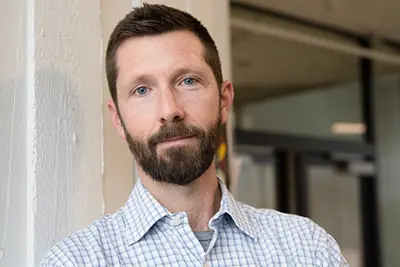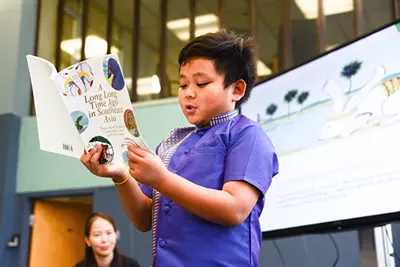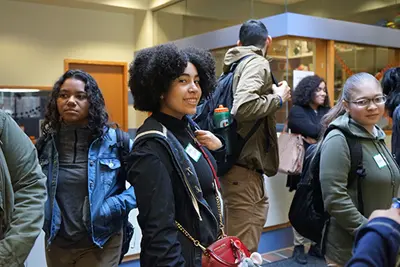Researchers Say Inclusive Teaching Methods Benefit All Children
 Image by Adrien Bisson
Image by Adrien Bisson
08/26/2020
By Katharine Webster
Education Asst. Prof. Johanna Tigert has experienced the challenges of learning and teaching multiple languages firsthand.
She grew up in Finland studying several languages, earned a university degree in Russian literature and education, and then moved to the United States and pursued a master’s degree in teaching English as a second language.
For her Ph.D., she researched the literacy and socialization of “heritage language learners” — children, like her own, who grow up speaking English but also want to learn or maintain their family’s heritage language.
Tigert is one of several College of Education faculty members who incorporate multilingual teaching methods into all of their classes, because research shows that children learn better when their primary language is supported. Research also demonstrates that all students, including those with learning disabilities, benefit from inclusive teaching methods, she says.
“Multilingualism is the norm everywhere except here” in the United States, Tigert says. “Multilingual students should not have to forsake their home language to learn English. We wouldn’t take the ‘English-only’ approach to any other skill a student has: You wouldn’t ask a student to stop riding a bicycle in order to learn how to drive a car.”
 Image by Adrien Bisson
Image by Adrien Bisson
Yet that’s exactly what happened after Massachusetts voters approved Ballot Question 2 in 2002, part of a wave of English-only ballot initiatives passed by states including California and Arizona that affected a generation of schoolchildren — and caused the loss of teaching expertise, too, says Assoc. Prof. of Education Phitsamay Uy.
“After Question 2, they did away with all the dual-language programs and dual-language support, and all of those bilingual teachers lost their jobs,” Uy says.
The pendulum is swinging back the other way, though, Uy says. After some Boston parents reported that they were being discouraged from seeking services for their multilingual children, the U.S. Justice Department investigated and, in 2010, ordered the district to provide support services to all multilingual students.
Now Massachusetts requires teachers in core subject areas — math, science, language arts and history — including elementary school teachers, to get training in “sheltered English immersion”: teaching students the language skills they need to learn a subject, instead of assuming that students already have them.
In the three years she has been at UMass Lowell, Tigert has been teaching a course in sheltered English instruction to master’s students and UTeach students, undergraduates who major in one of the STEM disciplines, minor in education and graduate with initial teaching licensure in their field. That course will also be required for undergraduate education majors who are seniors this fall.
 Image by Johanna Tigert
Image by Johanna Tigert
“Each lesson plan has two parts: a content part and a language part. And it really helps every student, because we aren’t born speaking the language of math, for example, so every student is learning the language of those disciplines at school. Now we’re just paying attention to that and explicitly teaching it,” Tigert says.
Sarah Bustin, a junior physics major in the UTeach program, says Tigert’s class was entirely hands-on. Last year, before the pandemic, class took place at the Daley School, a middle school in Lowell, where the education students ran a popular after-school program. They’d take turns presenting lesson plans and accompanying activities — a key way of engaging multilingual students — and then debrief after the younger students left for the day. For their theme, they chose the Middle Ages.
“It was really cool being off-campus and being immersed in that environment — and actually practicing what we learned with real kids,” says Bustin, who worked with fellow physics and UTeach student Stephen Gath on a slingshot experiment, to teach the children about potential and kinetic energy. “There were kids from all different cultures and backgrounds and lots of different languages.”
Since 2017, when the Massachusetts Legislature passed the Language Opportunity for Our Kids (LOOK) Act, the state has allowed schools to offer dual-language programs and transitional bilingual education, too, Uy says.
“Schools need a language policy that says, ‘Whatever the student needs, we will respond to that,’” Uy says. “Good teaching means that you are allowing everybody to get what they need, and no child is denied the opportunity to learn. Children need multiple strategies of learning and engaging.”
 Image by K. Webster
Image by K. Webster
Yet the language used in classrooms is only one challenge for multilingual learners, Uy says: Another is the language used on school websites, in emails and by education specialists, which may be a barrier that prevents families, especially recent immigrants, from getting involved or getting children the help they need.
Uy has done research in the Lawrence, Mass., public schools, helping them to partner with families and immigrant communities. Her course Understanding Families and Communities is required for undergrads, and she teaches related courses for graduate students.
“It’s about teaching in a community context, learning about the families and knowing it’s not a one-size-fits-all model,” she says. “It’s also not a one-way conversation. Parents might not come to your parent-teacher conference; you might need to go to a community organization to get information to them.”
For students with special needs, language barriers can complicate their diagnosis, says Asst. Prof. Robai Werunga, who teaches a sequence of classes on inclusive instructional methods for children with disabilities to undergraduates, who earn dual licensure in elementary education and teaching students with moderate disabilities from kindergarten through eighth grade.
That’s particularly evident in students whose first language is Spanish, Werunga says. Historically, they have been over-diagnosed with learning disabilities, while newer research suggests they are now under-diagnosed, with teachers attributing their struggles to language difficulties instead of a learning disability, she says. It’s not yet clear whether children who speak other languages are over- or under-diagnosed.
What is clear, Werunga says, is that multilingual families face barriers in accessing special education supports and services. Werunga is doing research now on immigrant families in Lowell who have children with disabilities.
“Language is a big barrier when it comes to getting support, and while Lowell does a good job of providing translation, that isn’t enough: Families also need clear explanations about special education services,” she says.




